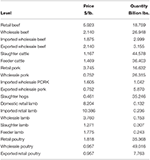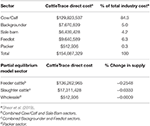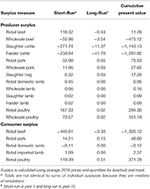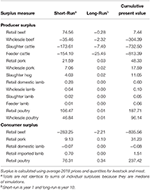Economic Impact of the Beef Cattle Industry
Introduction
The Us (U.S.) is relatively "behind" other countries in implementing a national animal identification (ID) and traceability plan. Other large beef exporters, including Argentine republic, Commonwealth of australia, Canada, European Marriage, New Zealand, and Uruguay, all take authorities mandated systems (Schroeder and Tonsor, 2012). Despite the lack of a national fauna ID and traceability plan, U.S. beefiness has remained internationally competitive and generally accepted as a safe source. This, along with fear of increased toll and other long-term implications, has led some industry stakeholders to disapprove of potential regime-mandated creature ID and traceability programs (Golan et al., 2004).
Beef product in the U.s.a. is highly segmented, which causes livestock to accept several changes of ownership between nascency and slaugher. The master production of cow-dogie operations is weaned calves, which are subsequently sold to stockers, backgrounders, or feedlots. Some calves from cow-calf operations are transferred directly to feedlots at, or around, the fourth dimension of weaning, in which case, they are referred to every bit "calf-feds" that remain in the feedlot prior to beingness harvested (Drouillard, 2018). The largest share of the dogie population, usually 60% or more, is first placed into a backgrounding or stocker functioning, or a combination thereof (USDA, 2018). Nigh cattle pass through a feedlot at some point before reaching slaughter. The segmentation, product differences, and geographical disbursement further complicates the tracing and tracking system.
In addition, at that place are over 103 million head of cattle in the United States, with 192,000 head and over ii.vi billion pounds of beef exported in 2018 (USDA-NASS, 2018a,b). This high volume of production and global need for U.S. beef complicates the ability to trace, or physically track a product, through the typical U.S. beef supply chain.
Several studies, including Coffey et al. (2005), have assigned an opportunity cost to the expected impact of a disease outbreak, specifically BSE (bovine spongiform encephalopathy), in the Us. These studies back up the positive impact that a traceability program could take on the U.S. beefiness industry in avoiding lost export markets and loss of inventory. Measuring the potential impacts of an outbreak has been considered from many unlike perspectives and all suggest a significant negative impact to the industry; and so much and so that the National Cattlemen'south Beef Clan included traceability in their Long-Range Plan for 2016–2020 (National Cattlemen'south Beef Association, 2017). However, determining the true costs and impacts of a traceability plan within the United States is difficult due to the nature of the U.S. supply chain, but is crucial every bit a national animal ID and traceability program is eminent. Understanding the potential economic impact of a traceability plan is important, especially in a large beefiness producing state such as Kansas. In add-on, it is of import to recognize which segments of the industry may exist affected the virtually.
The objective of this study is to analyze the economical impacts of an fauna ID and traceability system. Specifically, nosotros summate the direct costs of implementing an animal ID and traceability system, called CattleTrace, for each segment in the U.Southward. beefiness manufacture. Adjacent, we incorporated the toll estimates into a partial equilibrium model of the U.S. livestock and meat industry to make up one's mind the short- and long-run economic impacts to the various segments of the U.South. beef industry.
In 2018, a pilot plan, called CattleTrace, was launched with the support of industry stakeholders to brainstorm directing the beef industry toward a cohesive traceability programme. In January 2020, a new initiative, U.S. CattleTrace, combined the efforts of CattleTrace, which includes multiple partners, including the Kansas Livestock Association and others in Kansas, Missouri, Oklahoma, Kentucky, Oregon, and Washington, likewise equally traceability pilot projects underway in Florida and Texas (U.Southward. CattleTrace, 2020). The CattleTrace program extends from outset-to-end of the beef manufacture and includes participants from all segments of production. Current participation from beef industry stakeholders includes many cow-calf producers, 12 livestock markets, ii backgrounders, xvi feedlots, and 3 major packers (4 locations). While the CattleTrace programme began in Kansas, multiple states are now part of the system with various individual and public organizations establishing partnerships in an endeavor to illustrate how a national creature ID and traceability plan may look in the future. The post-obit analysis is based on the price interpretation of implementing a national animal ID and traceability programme structured as CattleTrace.
CattleTrace is a voluntary programme where cattle producers from all segments (cow/dogie, backgrounders and stockers, sale barns, feedlots, and packers) can select to participate. At the cow/dogie level, producers must implement the use of UHF identification for all calves leaving the bounds, and depending on size of the operation (economies of scale) either a wand tag reader or panel reader is required. Increased labor costs, tag costs, and reader costs are all taken into consideration as well as a large body of assumptions on fauna injury, homo injury, and more. Backgrounders and stockers are assumed to need replacement tags too equally readers (wand or panel depending on economics of scale) to meet the CattleTrace requirements. Sale barns will require panel readers, with a college quantity of panels required for larger facilities (economies of scale assumption). Feedyards are besides expected to implement the use of console readers and replacement tags if needed. All of these segments of the industry cost estimations brand assumptions nigh labor requirements, injuries, and more based on an extensive literature review and industry give-and-take. At the packer level, software implementation and panel readers are the biggest initial costs for the segment. All data is stored and managed by CattleTrace in a secure location.
Data and Methods
An annual multi-marketplace partial equilibrium model of the U.S. livestock and meat industry was employed to guess the economical impacts of industry costs incurred through the adoption of CattleTrace. In general, as additional costs are incurred throughout a vertically-related marketing chain, livestock, and meat prices and quantities are impacted. Furthermore, changes in prices at the retail level for beef volition influence the need for substitute products (e.chiliad., pork, poultry, and lamb). A traceability system could as well positively influence domestic and international demand for U.S. beef. However, the extent of these potential changes is hard to forecast.
The economic model utilized in this written report is an updated version of the multi-marketplace fractional equilibrium model documented in Pendell et al. (2010), Pendell et al. (2013) and Dennis et al. (2018). An equilibrium displacement model (EDM) allows for the estimation of the potential touch of a particular shock on the market, in this case, how implementing an animal ID and traceability program will bear upon prices and quantities on the livestock and meat markets. Such a model allows for changes in both supply and demand beyond multiple markets, in this example between beef, pork, poultry, and lamb.
The EDM contains an underlying fix of structural demand and supply functions. After totally differentiating the structural need and supply functions and converting to an elasticity form, the event is an EDM of the U.S. livestock and meat industry (run across Appendix Equations A1–A30). Later solving for the changes in the endogenous prices and quantities, changes in consumer and producer surplus tin be calculated using equations (one, 2), respectively:
CS and PS are defined as the consumer surplus and producer surplus, respectively. P and Q indicate price and quantity, respectively. Due east represents a relative change operator. z and w are the exogenous demand and supply shifters, respectively. The superscript i denotes the market level [r = retail, w = wholesale (processor/packer), s = slaughter (feeding), and f = feeder (farm)] and subscript m denotes the species (B = beefiness, M = pork, L = lamb, and Y = poultry).
The exogenous shock to the EDM model is the implementation of CattleTrace. The cost of implementing CattleTrace was estimated for each segment of the industry and took into account economies of scale. The EDM model as well relies on given elasticity estimates to properly estimate how the markets will respond to changes in supply and demand. The base yr toll and quantity data are from 2018 and reported in Table 1 (Livestock Marketing Information Center, 2019). Tabular array A1 provides the remaining market parameters, including the supply and need elasticities for the different bolt across the various sectors, which were retained every bit defined in Pendell et al. (2010) and Dennis et al. (2018).

Tabular array 1. U.S. prices and quantities used in analysis, 2018.
The five segments of the U.S. beef industry in this study include: cow/calf, backgrounder/stocker, sale barn, feedlot, and packer. The full cost estimates for each segment are $129.82 meg (cow/calf), $7.67 one thousand thousand (backgrounder/stocker), $6.44 million (sale befouled), $ix.64 1000000 (feedlot), and $0.51 meg (packer) (Shear et al., 2019; Table 2). The five group subtotals were summed to obtain the annual total cost for the unabridged beefiness cattle industry of adopting CattleTrace, $154.09 million. Costs associated with the moo-cow/calf and sale barns sectors are aggregated in the feeder cattle sector, backgrounder and feedlots are aggregated in the slaughter cattle sector, and packer costs are referred to equally wholesale costs in this economic analysis.

Table two. CattleTrace directly costs to industry and supply shocks used in partial equilibrium model.
The annual beefiness industry CattleTrace costs are distributed as: $0.51 million to the wholesale beef sector, $17.31 million to the slaughter cattle production sector and $136.26 1000000 to the farm sector (Table two). Using 2018 average prices and quantities for each market level, these price estimates represent the following percentage increases in CattleTrace costs relative to total value at each sector: 0.0009% at the wholesale beef level, 0.0333% at the slaughter cattle level, and 0.2548% at the farm level (Table 2). The percentage changes in costs at each marketplace level are estimated in a similar manner for all scenarios.
Scenarios
Four scenarios are considered when quantifying the economical impacts of CattleTrace. The showtime two scenarios differ in the proportion of costs borne by the producer. The final two scenarios focus on U.South. beef demand responses past domestic and international consumers. It is assumed that 100% of producers would adopt CattleTrace.
The scenarios are separated into four areas:
1) Effects of CattleTrace Costs with No Benefits
The impacts of increased costs resulting from CattleTrace are simulated. This simulation assumes both domestic and international consumer demand for U.S. beef is unaffected past CattleTrace. In other words, nosotros gauge the impacts of the costs associated with 100% adoption of CattleTrace assuming that no benefits accrue to the U.Southward. beef manufacture.
2) Furnishings of a Government Cost-Share of CattleTrace Costs with No Benefits
According to contempo inquiry past Mitchell et al. (2019), "results show that policies would be virtually effective at reducing costs at the cow-calf level or offering cost-shares for feedlot producers who want to procure cattle with electronic traceability." Similar to Scenario 1, we simulate the impacts of increased costs resulting from CattleTrace. Notwithstanding, we assume one/3 of the costs for RFID ear tags and electronic readers are borne past the producer while the regime is responsible for the remaining 2/3 of those costs. Like Scenario 1, this simulation assumes both domestic and international consumer demand for U.S. beef is unaffected by CattleTrace. In essence, we measure how a regime toll-share program for CattleTrace would impact the U.South. beefiness manufacture.
3) Increases in International Beef Need Needed to Beginning CattleTrace Costs
Adoption of CattleTrace, or whatsoever other animal identification and traceability system, could increase foreign consumer confidence in the U.Southward. beef arrangement. We gauge the increase in U.S. beefiness export demand (assuming constant domestic demand) that would exist needed to beginning producer costs of CattleTrace adoption costs.
4) Increases in Domestic Beef Demand Needed to Offset CattleTrace Costs
Similar to Scenario iii, nosotros estimate how much of a domestic beef demand enhancement would exist required (bold constant consign demand) to showtime producer costs of CattleTrace adoption costs.
Results
Effects of CattleTrace Costs With No Benefits
As expected, changes in prices and quantities for the U.S. beef manufacture were much larger when compared to the pork, poultry, and lamb industries. This is because the U.S. beefiness industry is the merely industry with an increase in costs every bit a result of CattleTrace. All changes in prices and quantities within the beef industry are consequent with an increment in CattleTrace costs at the wholesale, slaughter and farm levels. An increase in costs at the subcontract, slaughter, and wholesale levels shifts both the principal and derived supply functions, as well as, derived demand functions at the slaughter and farm levels. This results in retail and wholesale level beef prices to increase by 0.43 and 0.42%, respectively, while quantities reject by 0.xvi and 0.41%. Imported and exported wholesale beef, slaughter, and feeder cattle prices and quantities all decline. Slaughter cattle prices and quantities decline by 0.fifteen and 0.34%, respectively, while feeder cattle prices and quantities fall by 0.08 and 0.26%. Pork, poultry and lamb prices and quantities all increase, except for export quantities, by a small corporeality, equally consumers substitute away from beef to relatively cheaper protein sources in response to increased retail beefiness prices.
Tabular array iii presents producer surplus impacts due to the costs implementing CattleTrace. As expected, the brusk-run impacts (yr ane) are much larger than the long-run impacts (year 10) as producers are able to adapt to these changes in the long-run. In the short-run, the slaughter and feeder cattle sectors experience the largest losses at $271.vii and $238.0 million, respectively. The wholesale level loses $56.0 million. In the long-run, the feeder and slaughter cattle sectors lose $41.seven and $11.4 million, respectively, while the wholesale level lose $iii.5 million in producer surplus. The cumulative discounted present value of producer surplus losses over 10-years for the feeder cattle, slaughter cattle and wholesale beef sectors are $1,291 meg, $1,143 million and $475 million, respectively.

Table 3. Changes in producer and consumer surplus resulting from adopting cattletrace with no benefits (million $).
Effects of a Regime Toll Share of CattleTrace Costs With No Benefits
Results are similar to the scenario when producers bear all CattleTrace costs, except the impacts are smaller in magnitude. This results in retail and wholesale level beef prices to increase by 0.27 and 0.27%, respectively, while quantities decline by 0.10 and 0.26%. Imported and exported wholesale beef, slaughter, and feeder cattle prices and quantities all pass up. Slaughter cattle price and quantity fall by 0.10 and 0.22%, respectively, while feeder cattle cost and quantity fall by 0.07 and 0.16%. Pork, poultry, and lamb prices and quantities all increase, except for export quantities, by a small amount, as consumers substitute away from beef to relatively cheaper protein sources in response to increased retail beef prices.
Table iv presents producer surplus impacts due to the costs implementing CattleTrace. Like to the previous scenario, the short-run impacts are much larger than the long-run impacts. In the short-run, the slaughter and feeder cattle sectors experience the largest losses at $173.6 and $154.1 million, respectively, while the wholesale level lose $35.5 million. In the long-run, the feeder and slaughter cattle sectors lose $7.4 and $25.5 million, respectively, while the wholesale level lost $ii.three million in producer surplus. The cumulative discounted nowadays value of producer surplus losses over 10-years for the feeder cattle, slaughter cattle and wholesale beef sectors are $813 meg, $733 million, and $304 million, respectively.

Table 4. Changes in producer and consumer surplus resulting from a government cost share of cattletrace costs (million $).
Increases in International Beefiness Demand Needed to Offset CattleTrace Costs
As most major exporting countries accept traceability systems, implementing a national traceability plan could open up new markets or allow for quicker entry dorsum into the market afterwards a disease outbreak. This scenario was performed to decide the increment in international beef need needed so that the U.S. beefiness producer sectors do not lose any producer surplus. A permanent 17.vii% increase (equivalent to 558 million lbs.) in international demand for U.S. beefiness would exist needed such that producers practice non lose any surplus. To put this value into perspective, the quantity of U.S. beef exports varied from an increment of 21 to a 12% decrease between 2009 and 2018 (LMIC 2019). Furthermore, 28% (885 million lbs.), 20% (638 1000000 lbs.), and xiv% (449 million lbs.) of U.S. beef exports went to Nippon, Republic of korea, and Mexico, respectively, in 2018 (Livestock Marketing Information Center, 2019). Thus, maintaining market access to a single export market could completely first U.S. beefiness producer costs of CattleTrace.
Increases in Domestic Beef Demand Needed to Offset CattleTrace
As demand for transparency by U.Southward. consumers continues to increase, implementing a national animal ID and traceability program could potentially have a positive bear upon on consumer demand for beefiness. This scenario was performed to determine the increase in domestic beef need needed and so that the U.S. beef producer sectors do not lose any producer surplus. A permanent 1.9% increase (or 356 million lbs.) in domestic need for U.S. beef would exist needed such that producers do not lose whatsoever surplus. Between 2009 and 2018, annual domestic retail beef need, on average, varied between an increase of 4.14% to a decrease of iv.10% from the previous year. Thus, a modest increase in domestic consumer demand for beef needed to offset the costs of CattleTrace has been experienced recently.
When considering economies of scale, the cost of implementing CattleTrace ranged from $ii.84 to $6.06/head for moo-cow/calf producers. For backgrounders, the cost of implementing CattleTrace ranged from $0.41 to $0.83/head. The boilerplate cost for auction barns was $0.14/head, and the cost of implementing CattleTrace for feedlots ranged from $0.33 to $0.55/head. The boilerplate price to packers ranged from $0.02 to $0.18/head. The overall direct toll to the beefiness industry was estimated to be $154.09 meg.
A partial equilibrium model of the U.S. livestock and meat sector was used to evaluate the impacts of adopting CattleTrace on producers. Assuming no changes in domestic and international need for U.Southward. beef, producers at the wholesale, slaughter, and feeder levels lose $475 meg, $i,143 1000000, and $1,291 meg, respectively, in 10-year discounted cumulative producer surplus. If a government cost share plan is implemented (i.e., 1/3 of the costs of ear tags and readers are borne past the producers while the other 2/3 of the costs are borne by the government), the producers losses are smaller; feeder, slaughter and wholesale levels lose $813 million, $733 million, and $304 one thousand thousand, respectively. With a possibility of increasing consumer need as a consequence of traceability, ii simulations evaluated the increment in international and domestic demand required to commencement the costs of CattleTrace to U.South. cattle producers. A 17.7% and 1.nine% increment in international and domestic beef demand would be required to completely offset the producer costs of CattleTrace, respectively.
Conclusion
This analysis is an overview of the costs and economic impacts of implementing CattleTrace, a ultra-high frequency based radio frequency identification (UHF-RFID) technology-based traceability program. The main objectives of this analysis was to provide an guess of the direct cost to the industry for implementing CattleTrace, as well as, estimate the economic bear upon of a national fauna identification (ID) and traceability programme for the beefiness manufacture. Determining the direct costs to the manufacture required estimating costs within each industry sector.
This analysis suggests that your 'typical' minor fluctuations in domestic and international beef demand on average could get-go the direct costs to producers and the industry every bit a whole. These results may encourage more industry support for a national animal ID and traceability program; however some concerns, such every bit data direction, cannot be addressed in this model and, therefore, remain as hurdles to the implementation of a national program.
Data Availability Statement
The raw information supporting the conclusions of this commodity will exist made bachelor by the authors, without undue reservation.
Author Contributions
HS and DP contributed to the conception and design of the written report. HS compiled a crude typhoon of the manuscript, incorporating the results department compiled past DP. Both authors contributed to manuscript revision, read, and approved the submitted version.
Funding
The authors acknowledge the financial assistance provided by Kansas Department of Agriculture. The views expressed herein are those of the authors and should not be attributed to KDA.
Conflict of Interest
The authors declare that the research was conducted in the absence of whatsoever commercial or financial relationships that could be construed as a potential conflict of interest.
Supplementary Material
The Supplementary Material for this commodity tin can exist establish online at: https://www.frontiersin.org/articles/ten.3389/fanim.2020.552386/full#supplementary-material
References
Coffey, B., Mintert, South., Play a trick on, S., Schroeder, T., and Valentine, Fifty. (2005). The Economical Touch of BSE on the U.South. Beefiness Manufacture: Production Value Losses, Regulatory Costs, and Consumer Reactions. Kansas State Academy Agricultural Experimental Station and Cooperative Extension Service. Report No. MF-2678, Manhattan, NY.
Google Scholar
Drouillard, J. S. (2018). Current state of affairs and future trends for beefiness production in the United States of America - a review. Asian Austr. J. Anim. Sci. 31, 1007–1016. doi: 10.5713/ajas.eighteen.0428
PubMed Abstract | CrossRef Full Text | Google Scholar
Golan, E., Krissoff, B., Kuchler, F., Calvin, Fifty., Nelson, K., and Price, Chiliad. (2004). Traceability in the U.Due south. Nutrient Supply: Economic Theory and Industry Studies. ERS Agricultural Economic Report No. 830. USDA, Washington, DC.
Google Scholar
Livestock Marketing Information Middle (2019). Various Reports and Data. LMIC Lakewood, CO. Bachelor online at: https://lmic.info/ (accessed May xx, 2019).
Google Scholar
Mitchell, J. 50., Tonsor, G. T., and Schultz, L. 50. (2019). Comparing Willingness to Supply and Willingness to Pay for Cattle Traceability: A Novel Assessment of Both Supply and Demand Factors Driving Provision of Production Practice Data in Modern Nutrient Systems. Available online at: https://econpapers.repec.org/paper/agsaaea19/291158.htm (accessed November 7, 2019).
Google Scholar
Pendell, D. L., Brester, Chiliad. W., Schroeder, T. C., Dhuyvetter, K. C., and Tonsor, G. T. (2010). Animal identification and tracing in the United States. Am. J. Agric. Econ. 92, 927–940. doi: x.1093/ajae/aaq037
CrossRef Full Text | Google Scholar
Pendell, D. L., Tonsor, G. T., Dhuyvetter, K. C., Brester, K. W., and Schroeder, T. C. (2013). Evolving beef export market access requirements for historic period and source verification. Food Policy 43, 332–340. doi: 10.1016/j.foodpol.2013.05.013
CrossRef Full Text | Google Scholar
Schroeder, T., and Tonsor, G. (2012). International cattle ID and traceability: competitive implications for the US. Food Policy 37, 31–40. doi: ten.1016/j.foodpol.2011.10.005
CrossRef Full Text | Google Scholar
Source: https://www.frontiersin.org/articles/10.3389/fanim.2020.552386/full
0 Response to "Economic Impact of the Beef Cattle Industry"
Post a Comment